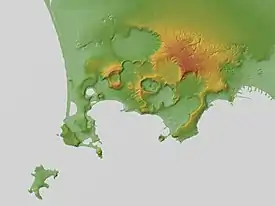Phlegraean Fields
The Phlegraean Fields (Italian: Campi Flegrei [ˈkampi fleˈɡrɛi]; Neapolitan: Campe Flegree; from Ancient Greek φλέγω phlégō 'to burn')[2] is a large region of supervolcanic calderas situated to the west of Naples, Italy. It was declared a regional park in 2003.
| Phlegraean Fields | |
|---|---|
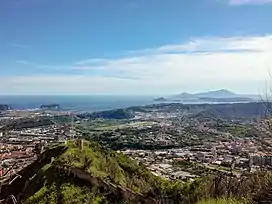 Phlegraean Fields view from Naples | |
| Highest point | |
| Elevation | 458 m (1,503 ft)[1] |
| Coordinates | 40.827°N 14.139°E[1] |
| Naming | |
| Native name | Campi Flegrei (Italian) |
| Geography | |
| Location | Italy |
| Geology | |
| Age of rock | 40,000 years |
| Mountain type | Caldera[1] |
| Volcanic arc/belt | Campanian volcanic arc |
| Last eruption | September to October 1538[1] |
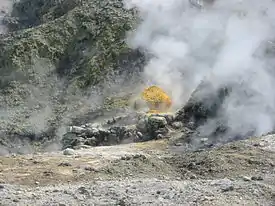
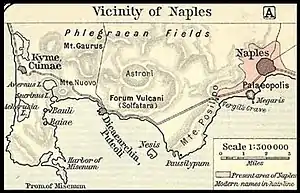
The area of the caldera consists of 24 craters and volcanic edifices; most of them lie under water. Hydrothermal activity can be observed at Lucrino, Agnano and the town of Pozzuoli. There are also effusive gaseous manifestations in the Solfatara crater, which was regarded in ancient times as the mythological home of the Roman god of fire, Vulcan.[3] This area is monitored by the Vesuvius Observatory.[4] It is considered a supervolcano.[5][6][7]
The area also features bradyseismic phenomena, which are most evident at the Macellum of Pozzuoli (misidentified as a temple of Serapis): bands of boreholes left by marine molluscs on marble columns show that the level of the site in relation to sea level has varied.
Geological phases
Three geological phases or periods are recognised and distinguished.[8]
- The First Phlegraean Period. It is thought that the eruption of the Archiflegreo volcano occurred about 39,280 ± 110 years (older estimate ~37,000 years) ago, erupting about 200 km3 (48 cu mi) of magma (500 km3 (120 cu mi) bulk volume)[9] to produce the Campanian Ignimbrite eruption.[10] Its Volcanic Explosivity Index (VEI) was 7. "The dating of the Campanian Ignimbrite Eruption (CI) to ~37,000 calendar years B.P. draws attention to the coincidence of this volcanic catastrophe and the suite of coeval, Late Pleistocene biocultural changes that occurred within and outside the Mediterranean region. These included the Middle to Upper Paleolithic cultural transition and the replacement of Neanderthal populations by anatomically modern Homo sapiens, a subject of sustained debate.[11] No less than 150 km3 of magma were extruded in this eruption (the CI eruption), traces of which can be detected in Greenland ice cores. As widespread discontinuities in archaeological sequences are observed at or after this eruption, a significant interference with ongoing human processes in Mediterranean Europe is hypothesized."[12] It is possible that these eruptions drove Neanderthals to extinction and cleared the way for modern humans to thrive in Europe and Asia.[13] The area is characterised by banks of piperno and pipernoid grey tuff at Camaldoli hill, as in the northern and western ridge of Mount Cumae; other referable deep products are those found at Monte di Procida, recognizable in the cliffs of its coast.
- The Second Phlegraean Period, between 35,000–10,500 years ago.[8] This is characterized by the Neapolitan yellow tuff that is the remains of an immense underwater volcano, with a diameter of c. 15 kilometres (9.3 mi); Pozzuoli is at its center. Approximately 12,000 years ago the last major eruption occurred, forming a smaller caldera inside the main caldera, with its centre where the town of Pozzuoli lies today.
- The Third Phlegraean Period, between 8,000 – 500 years ago.[8] This is characterized by white pozzolana, the material that forms the majority of volcanos in the Fields. Broadly speaking, it can be said there was initial activity to the southwest in the zone of Bacoli and Baiae (10,000–8,000 years ago); intermediate activity in an area centred between Pozzuoli, Spaccata Mountain and Agnano (8,000–3,900 years ago); and more recent activity towards the west, which formed Lake Avernus and Monte Nuovo (New Mountain) (3,800–500 years ago).
- Volcanic deposits indicative of eruption have been dated by argon at 315,000, 205,000, 157,000 and 18,000 years ago.
More recent history
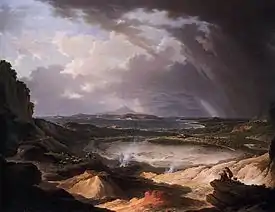
The caldera, essentially at ground level as of 2023, is accessible on foot. It contains many steam-emitting fumaroles and over 150 pools (at the last count) of boiling mud. Several subsidiary cones and tuff craters, one filled by Lake Avernus, lie within the caldera.
In 1538, an eight-day eruption in the area deposited enough material to create a new hill, Monte Nuovo. It has risen about 2 m (7 ft) from ground level since 1970.
The volcanic island of Ischia suffered three destructive earthquakes in 1828, 1881, and the most destructive one in 1883, with a magnitude of 4.2–5.2 and causing catastrophic shaking assigned XI (Extreme) on the MCS scale. Extreme damage was reported on the island, and over 2,000 residents perished.[14]
At present, the Phlegraean Fields area comprises the Naples districts of Agnano and Fuorigrotta, the area of Pozzuoli, Bacoli, Monte di Procida, Quarto, the Phlegraean Islands (Ischia, Procida and Vivara).
A 2009 journal article stated that inflation of the caldera centre near Pozzuoli might presage an eruptive event within decades.[15] In 2012 the International Continental Scientific Drilling Program planned to drill 3.5 kilometres (11,000 feet) below the earth's surface near Pompeii, in order to monitor the massive molten rock chamber below and provide early warning of any eruption. Local scientists were worried that drilling could precipitate an eruption or earthquake; programme scientists said it was no different from industrial drilling in the area. The drilling was halted in 2010, but later resumed. A Reuters article emphasized that the area could produce a "super volcano" that might kill millions.[16]
A study from the Istituto Nazionale di Geofisica e Vulcanologia reported that the volcanic unrest of the Campi Flegrei caldera from January 2012 to June 2013 was characterised by rapid ground uplift of about 11 cm (4 in), with a peak rate of about 3 cm (1 in) per month during December 2012. It added that from 1985 to 2011 the dynamics of ground uplift were mostly linked to the caldera's hydrothermal system, and that this relation broke down in 2012. The driving mechanism of the ground uplift changed to periodical emplacement of magma within a flat sill-shaped magmatic reservoir about 3,000 m (9,843 ft) in depth, 500 m (1,640 ft) south from the port of Pozzuoli.[17]
In December 2016, activity became so high that an eruption was feared.[18] In May 2017 a new study by University College London and the Vesuvius Observatory published in Nature Communications concluded that an eruption might be closer than previously thought. The study found that the geographical unrest since the 1950s has a cumulative effect, causing a build-up of energy in the crust and making the volcano more susceptible to eruption.[19][20][21][22]
On 21 August 2017 there was a magnitude 4 earthquake on the western edge of the Campi Flegrei area.[23] Two people were killed and many more people injured in Casamicciola on the northern coast of the island of Ischia, which is south of the epicentre.[24]
Activity since 2020
A February 2020 status report indicated that inflation around Pozzuoli continued at steady rates, with a maximum average of 0.7 cm per month since July 2017. Gas emissions and fumarole temperatures did not change significantly.[25][26]
On Sunday April 26, 2020, a moderate earthquake swarm hit Campi Flegrei caldera, with about 34 earthquakes ranging between magnitude 0 and magnitude 3.1 centered around the port city of Pozzuoli. The strongest quake in the sequence was of magnitude 3.1, the strongest at the time since the last major period of unrest and rapid uplift in 1982-1984. However, no new fumaroles were reported.[27]
Volcanic activity was reported in January 2022 to be increasing.[28] In the year to September 2023 seismic activity had intensified, particularly in the later months. On 27 September 2023, a magnitude 4.2 earthquake—the strongest in 40 years—prompted the preparation of contingency plans to evacuate up to 360,000 people in the area.[29] Despite a further 4.0 quake on 2 October, most volcanologists consider that a major eruption is not expected imminently.[30] The best-case scenario was deemed to be the activity ending, as happened after much activity on the 1980s; the worst would be an eruption like the one of 1538. A study by Italy's National Institute of Geophysics and Volcanology (INGV) and University College London (UCL) in June 2023 concluded that the volcano was edging towards "breaking point" and in an "extremely dangerous state".[31] Nello Musumeci, Italian minister for civil protection, was to ask Neapolitan local officials for an "acceleration in the drafting of exodus plans in the event of an emergency";[29] he said that evacuation would only be carried out in the event of "extreme necessity".[30]
Geoheritage designation
In respect of its 18th and 19th century role in the development of geoscience, not least volcanology, this locality was included by the International Union of Geological Sciences (IUGS) in its assemblage of 100 'geological heritage sites' around the world in a listing published in October 2022.[32]
Wine
Italian wine, both red and white, under the Campi Flegrei DOC appellation comes from this area. Grapes destined for DOC production must be harvested up to a maximum yield of 12 tonnes/hectare for red grape varieties, and 13 tonnes/ha for white grape varieties. The finished wines need to be fermented to a minimum alcohol level of 11.5% for reds and 10.5% for whites. While most Campi Flegrei wines are blends, varietal wines can be made from individual varieties, provided the variety used comprises at least 90% of the blend and the wine is fermented to at least 12% alcohol for reds and 11% for whites.[33]
Red Campi Flegrei is a blend of 50–70% Piedirosso, 10–30% Aglianico and/or Sciascinoso and up to 10% of other local (both red and white) grape varieties. The whites are composed of 50–70% Falanghina, 10–30% Biancolella and/or Coda di Volpe, with up to 30% of other local white grape varieties.[33]
Cultural importance
Campi Flegrei has had strategic and cultural importance.
- The area was the site of quarries for piperno stone, an ignimbrite (welded tuff), a stone that was used to build much of Naples; piperno "is probably the most important building stone of Naples, used over a time-span from at least the Roman age until the beginning of the 20th century."[34][35] Piperno stone was used in the construction of Pompeii, along with other stone including Naples yellow tuff, foamy basalt, and limestone.
- The area was known to the ancient Greeks, who had a colony nearby at Cumae, the seat of the Cumaean Sibyl.
- The beach of Miliscola, in Bacoli, was the Roman military academy headquarters.
- Lake Avernus was believed to be the entrance to the underworld, and is portrayed as such in the Aeneid of Virgil. During the civil war between Octavian and Antony, Agrippa tried to turn the lake into a military port, the Portus Julius.
- Baiae, now partially submerged, was a fashionable coastal resort and was the site of summer villas of Julius Caesar, Nero, and Hadrian (who died there).
- In Pozzuoli is the Flavian Amphitheatre, the third-largest Italian amphitheatre after the Colosseum and the Capuan Amphitheatre.
- The Via Appia passed through the comune of Quarto, entirely built on an extinguished crater.
- The Cave of Dogs, a famous tourist attraction during the early modern period, is on the eastern side of the Fields.
- Europe's youngest mountain,[36] Monte Nuovo, is here. A WWF oasis lies beside the enormous Astroni crater.
- The tombs of Agrippina the Elder and Scipio Africanus are here.
- At Baiae, now in the comune of Bacoli, the most ancient hot spring complex was built for the richest Romans. It included the largest ancient dome in the world before the construction of the Roman Pantheon.
- Astronomical broadcaster and writer Patrick Moore used to cite these Fields as an example of why the impact craters on the Moon must be of volcanic origin, which was thought to be the case until the 1960s.
- There is a theory that the Campanian Ignimbrite super-eruption around about 39,280 ± 110 years ago contributed to the extinction of the Neanderthals, based on evidence from Mezmaiskaya cave in the Caucasus Mountains of southern Russia.[37]
References
- "Campi Flegrei". Global Volcanism Program. Smithsonian Institution. Retrieved 2016-12-23.
- "flegreo". Garzantilinguistica. Retrieved September 20, 2016.
- Kozák, Jan; Čermák, Vladimír, eds. (2010). "Phlegraean Fields". The Illustrated History of Natural Disasters. Dordrecht and Heidelberg: Springer Verlag. pp. 67–71. doi:10.1007/978-90-481-3325-3_6. ISBN 978-90-481-3325-3. LCCN 2010920318.
- Giudicepietro, Flora. "Campi Flegrei - stato attuale".
- Howard, Brian Clark (22 December 2016). "One of Earth's Most Dangerous Supervolcanoes Is Rumbling". Nationalgeographc.com. National Geographic.
- "Getting to know the Phlgrean Fields". 11 May 2019.
- "The supervolcano in italy; Campi Flegrei". GeologyHub.
- Brand, Helen. Volcanism and the Mantle: Campi Flegrei (PDF) (Report). Archived from the original (PDF) on 2012-08-10. Retrieved 25 September 2005.
- Fisher, Richard V.; Giovanni Orsi; Michael Ort; Grant Heiken (June 1993). "Mobility of a large-volume pyroclastic flow — emplacement of the Campanian ignimbrite, Italy". Journal of Volcanology and Geothermal Research. 56 (3): 205–220. Bibcode:1993JVGR...56..205F. doi:10.1016/0377-0273(93)90017-L. Retrieved 2008-09-20.
- Fedele, Francesco G.; et al. (2002). "Ecosystem Impact of the Campanian Ignimbrite Eruption in Late Pleistocene Europe". Quaternary Research. 57 (3): 420–424. Bibcode:2002QuRes..57..420F. doi:10.1006/qres.2002.2331. S2CID 129476314.
- Neanderthal Apocalypse Documentary film, ZDF Enterprises, 2015. Retrieved 26 January 2016.
- De Vivo, B.; G. Rolandi; P. B. Gans; A. Calvert; W. A. Bohrson; F. J. Spera; H. E. Belkin (November 2001). "New constraints on the pyroclastic eruptive history of the Campanian volcanic Plain (Italy)". Mineralogy and Petrology. 73 (1–3): 47–65. Bibcode:2001MinPe..73...47D. doi:10.1007/s007100170010. S2CID 129762185.
- "Volcanoes Wiped out Neanderthals, New Study Suggests". ScienceDaily. Oct 7, 2010. Retrieved Oct 10, 2010.
The research is reported in the October issue of Current Anthropology
- S. Carlino; E. Cubellis; A. Marturano (2010). "The catastrophic 1883 earthquake at the island of Ischia (southern Italy): macroseismic data and the role of geological conditions". Natural Hazards. 52 (231): 231–247. doi:10.1007/s11069-009-9367-2. hdl:10.1007/s11069-009-9387-y. S2CID 140602189.
- Isaia, Roberto; Paola Marianelli; Alessandro Sbrana (2009). "Caldera unrest prior to intense volcanism in Campi Flegrei (Italy) at 4.0 ka B.P.: Implications for caldera dynamics and future eruptive scenarios". Geophysical Research Letters. 36 (L21303): L21303. Bibcode:2009GeoRL..3621303I. doi:10.1029/2009GL040513.
- Antonio Denti, "Super volcano", global danger, lurks near Pompeii, Reuters, August 3, 2012.
- D'Auria, Luca; Susi Pepe; Raffaele Castaldo; Flora Giudicepietro; Giovanni Macedonio; Patrizia Ricciolino; Pietro Tizzani; Francesco Casu; Riccardo Lanari; Mariarosaria Manzo; Marcello Martini; Eugenio Sansosti; Ivana Zinno (2015). "Magma injection beneath the urban area of Naples: a new mechanism for the 2012–2013 volcanic unrest at Campi Flegrei caldera". Scientific Reports. 5: 13100. Bibcode:2015NatSR...513100D. doi:10.1038/srep13100. PMC 4538569. PMID 26279090.
- "Naples astride a rumbling mega-volcano".
- "Campi Flegrei volcano eruption possibly closer than thought".
- "One of World's Most Dangerous Supervolcanoes is Rumbling". 22 December 2016.
- "One of the world's most terrifying supervolcanoes is showing signs of reawakening in Italy". Independent.co.uk. 21 December 2016. Archived from the original on 2022-05-26.
- "Italian Supervolcano Could be Closer to Erupting Than Previously Thought". 15 May 2017.
- "M 4.3 - 5km NW of Monte di Procida, Italy". USGS.
- "Ischia earthquake: cheers go up as rescuers free third trapped brother". Guardian. 22 August 2017.
- "Campi Flegrei volcano (Italy) status report: no significant variations in activity". www.volcanodiscovery.com. 21 November 2019.
- "Campi Flegrei volcano (Italy) status report: continuing slow inflation". www.volcanodiscovery.com. 27 February 2020.
- "Campi-Flegrei-volcano-(Italy):Seismic swarm reported". www.volcanodiscovery.com. 27 April 2020.
- Europe's super volcano. Deutsche Welle (4' video). 21 January 2022.
- Giuffrida, Angela (28 September 2023). "Fears rise of volcanic eruption near Naples after strongest earthquake in 40 years". The Guardian.
- "Italy plans for mass evacuation as quakes continue around supervolcano". The Guardian. Reuters. 5 October 2023.
- "Parts of Italian volcano 'stretched nearly to breaking point', study finds". AFP. 9 June 2023. citing Kilburn, C. R. J.; Carlino, S; Danesi, S (2023). et al. "Potential for rupture before eruption at Campi Flegrei caldera, Southern Italy". Commun Earth Environ. 4 (190). doi:10.1038/s43247-023-00842-1.
- "The First 100 IUGS Geological Heritage Sites" (PDF). IUGS International Commission on Geoheritage. IUGS. Retrieved 3 November 2022.
- P. Saunders Wine Label Language pg 132 Firefly Books 2004 ISBN 1-55297-720-X
- Calcaterra, Domenico; Cappelletti, Piergiulio; Langella, Alessio; Morra, Vincenzo; Colella, Abner; De Gennaro, Roberto (2000). "The building stones of the ancient centre of Naples (Italy): Piperno from Campi Flegrei. A contribution to the knowledge of a long-time-used stone". Journal of Cultural Heritage. 1 (4): 415–427. doi:10.1016/S1296-2074(00)01097-9.
- Marra, F.; Palladino, D. M.; Licht, O. A. Boni (2022). "The peperino rocks: Historical and volcanological overview". Bulletin of Volcanology. 84 (7): 69. Bibcode:2022BVol...84...69M. doi:10.1007/s00445-022-01573-5. hdl:11573/1660768. S2CID 249873677.
- "Pozzuoli: history, archeology, art, architecture, environment".
- Liubov Vitaliena Golovanova; Vladimir Borisovich Doronichev; Naomi Elancia Cleghorn; Marianna Alekseevna Koulkova; Tatiana Valentinovna Sapelko; M. Steven Shackley (October 2010). "Volcanoes Wiped out Neanderthals, New Study Suggests" (news release). Current Anthropology. 51 (5): 655–691. doi:10.1086/656185. S2CID 144299365.
Significance of Ecological Factors in the Middle to Upper Paleolithic Transition
Further reading
- Volcanism in the Campania Plain: Vesuvius, Campi Flegrei and Ignimbrites. Elsevier. 2006. ISBN 978-0-08-048166-1.
- Helmholtz Association of German Research Centres (16 Oct 2012). "An extremely brief reversal of the geomagnetic field, climate variability and a super volcano". Science X Network – via phys.org.
